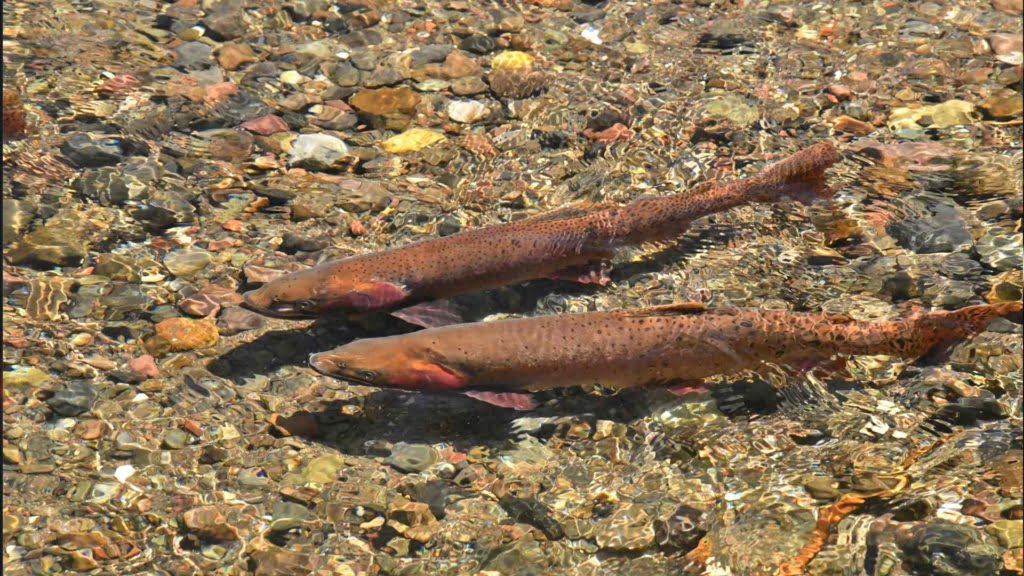Key Takeaways
| Fact | Description |
| Scientific Name | Oncorhynchus clarkii bouvieri |
| Habitat | Originally from places like the Yellowstone River, Snake River, and Falls River drainages. They are required to live in cold, clean water, whether it’s in a stream or a lake. |
| Diet | aquatic insects such as mayflies, stoneflies, caddisflies, as well as other small aquatic animals, terrestrial insects, leeches, amphipods, worms, small aquatic invertebrates like water fleas and copepods, smaller fish, fish eggs, small rodents, frogs, algae, other plants, and tiny water organisms called plankton |
| Conservation Status | Even though the Yellowstone cutthroat trout is considered a sensitive species, the US Fish and Wildlife Service concluded that Yellowstone cutthroat trout does not warrant listing as a threatened species under the Endangered Species Act. |
| Lifespan | 4-6 Years |
Introduction to Yellowstone Cutthroat Trout
The Yellowstone cutthroat trout, which goes by the scientific name Oncorhynchus clarkii bouvieri, is a subspecies of cutthroat trout (Oncorhynchus clarkii). This fish is a freshwater fish and it’s part of the salmon family.
Physical Appearance
Yellowstone cutthroat trout has a red slash along its jaw, which is common to all cutthroat varieties. Its body is mostly yellow-brown with darker olive or gray hues on the back, and lighter yellow on the sides. The black spotting pattern is highly variable, but there are few to no spots on the head.
Habitat and Distribution
Yellowstone cutthroat trout, a fish that’s originally from places like the Yellowstone River, Snake River, and Falls River drainages. This fish is required to live in cold, clean water, whether it’s in a stream or a lake. The variety of habitats resulted in the evolution of various life history types among Yellowstone cutthroat trout.
Diet
Yellowstone cutthroat trout have a pretty varied diet. They eat a lot of different things, like aquatic insects such as mayflies, stoneflies, and caddisflies, as well as other small aquatic animals. They also eat terrestrial insects that fall into the water. In Yellowstone Lake, they like to eat leeches, amphipods, worms, and small aquatic invertebrates like water fleas and copepods. But that’s not all! They also eat smaller fish, fish eggs, small rodents, frogs, algae and other plants, and tiny water organisms called plankton.
Reproduction
Yellowstone cutthroat trout have their babies, or spawn, in rivers or streams from the end of April to the middle of July. By the time they’re 3 years old, they’re sexually matured and capable of spawning, although some might start a year earlier when they’re 2. Most of these trout has a lifespan for about 4 years, but some can live up to 6 years. More than half of the catchable fish don’t survive each year, most of these fish die because of natural causes.
Importance and Conservation
Ecological Importance
Yellowstone cutthroat trout are really important to the ecosystem. They’re what’s known as a keystone species, which means a lot of other animals depend on them for food. In fact, about 16 different kinds of birds, as well as mammals like bears, river otters, and mink, count on these trout as a major part of their diet.
Conservation Status and Threats
Even though it is considered a sensitive species, the US Fish and Wildlife Service concluded that Yellowstone cutthroat trout does not warrant listing as a threatened species under the Endangered Species Act.
But that doesn’t mean everything is perfect for these fish. Their numbers have been going down in their natural habitat in the Intermountain West. This is because of a few different reasons, like other fish species that aren’t native to the area competing with them for food and space, or even eating them. They’re also losing their genetic integrity through hybridization, which is when they mix with other types of fish. On top of that, their habitat is being damaged, and they’re being caught by people who like to fish.
Conservation Efforts
From 2007 to 2020, the Western Native Trout Initiative provide a lot of money, $605,146 to be exact, to help the Yellowstone Cutthroat Trout. They funded 27 different projects. These projects did a lot of things like building and fixing barriers, restoring the trout’s habitat, fish passage, telemetry studies, and public outreach and education.
Conclusion
The Yellowstone cutthroat trout is an important species in the Greater Yellowstone Ecosystem. Despite facing numerous threats, efforts are being made to conserve this species and restore its population. Through continued conservation efforts, we can ensure the survival of this keystone species for future generations.
References:

